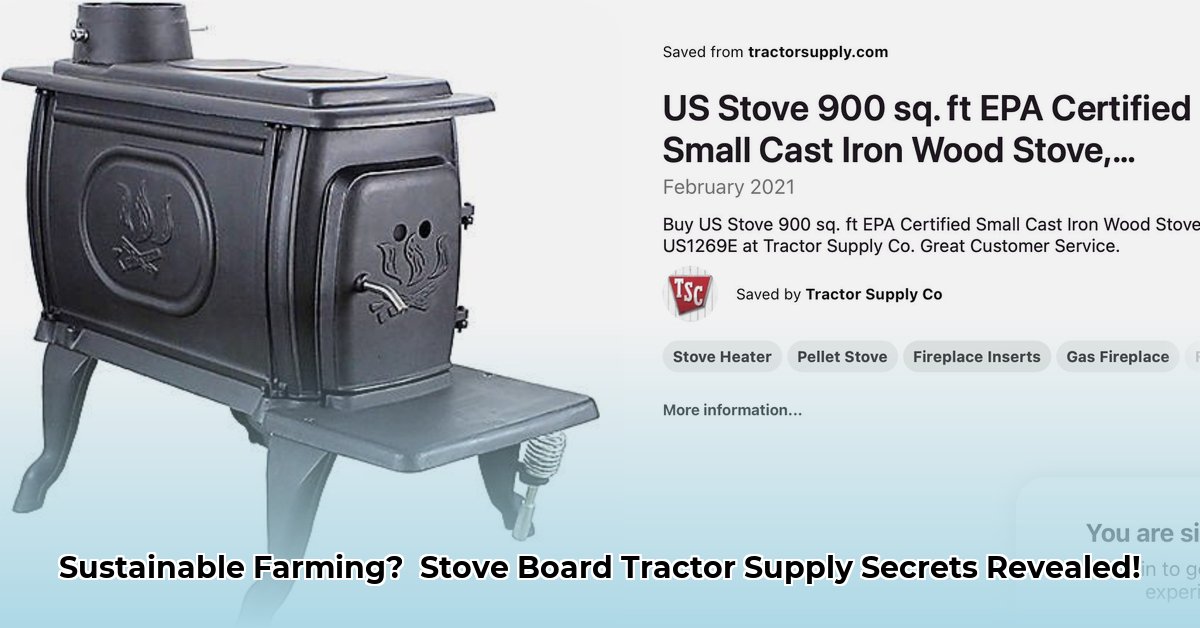
Harnessing the Unexpected: Stove Boards for Sustainable Agriculture
Let's explore the surprisingly versatile stove board from Tractor Supply and its potential applications in sustainable farming. While research specifically on stove boards in this context is limited, their heat-resistant properties suggest several innovative uses. This article examines potential applications, highlighting how this affordable tool can contribute to environmentally friendly and efficient farming practices. For more DIY sustainable farming ideas, check out this helpful resource: chicken tractor plans.
Warming Your Greenhouse the Sustainable Way
Imagine a small-scale farmer seeking cost-effective and eco-friendly greenhouse heating. A strategically placed stove board, acting as a heat reflector near a heat source (wood stove, propane heater, or even sunlight), can distribute warmth more evenly. This reduces wasted energy, lowering energy bills and minimizing the farm's carbon footprint. (Sustainable Farming Practices: Reducing Energy Consumption)
How to Optimize Greenhouse Heating with Stove Boards:
- Strategic Positioning: Experiment with the stove board's placement to maximize heat reflection towards plants.
- Ventilation Control: Ensure proper airflow to prevent overheating; don't seal the greenhouse completely.
- Continuous Monitoring: Regularly monitor plant health and temperature; adjust the board's position or ventilation as needed. Different stove board types and sizes may require varying approaches.
"Careful monitoring is crucial," says Dr. Emily Carter, Agricultural Engineer at Cornell University. "Overheating can damage plants, so finding the right balance between heat retention and ventilation is key."
Sustainable Crop Drying with Stove Board Heat
Many crops, like herbs and some fruits, require slow, even drying. Traditional methods are often inefficient and energy-intensive. A stove board, positioned beneath a drying rack, can provide a gentle, low-heat environment ideal for preserving the quality of delicate produce while minimizing spoilage.
Improving Crop Drying Efficiency:
- Establish a Drying Rack: Arrange crops on a suitable rack above the stove board.
- Heat Control: The effectiveness depends on factors such as crop type, ambient temperature, and humidity.
- Monitor Conditions Carefully: Regular checks are essential; adjust setup if necessary. Experimentation will determine ideal conditions.
A practical tip: "Consider using multiple smaller stove boards instead of one large one for more precise heat control in drying applications", advises John Miller, Owner of Miller's Organic Farm.
Beyond the Greenhouse and Drying: Expanding Applications
While greenhouse heating and crop drying represent primary applications, stove boards might prove useful in other areas. Farmers could experiment with using boards as heat sinks for tasks such as composting or warming seedling trays. Further research and practical experimentation are needed to fully explore their potential.
"The applications are truly limitless," explains Sarah Chen, Sustainable Farming consultant, "It's a matter of innovative thinking and practical application within the context of sustainable farming."
Analyzing the Pros and Cons: A Balanced Perspective
Stove boards, while offering potential benefits, have limitations. A realistic assessment helps farmers make informed decisions.
| Advantages | Disadvantages |
|---|---|
| Enhanced greenhouse heat efficiency | Requires careful placement and monitoring to avoid damage. |
| Even heat distribution for crop drying | Performance varies with board type, crop, environmental factors. |
| Reduced reliance on energy methods | Not suitable for all crops and climates. |
| Relatively inexpensive | Durability can vary; replacement might be necessary. |
The Future of Stove Boards in Sustainable Agriculture
The use of stove boards in sustainable agriculture is still in its early stages. Further research, farmer experimentation, and data collection are needed to fully understand their long-term potential. This includes investigating various board materials, sizes, and optimal usage conditions for a variety of crops and climates.
This is an exciting area of sustainable agriculture innovation, demonstrating how simple, affordable tools can play a significant role in creating more efficient, eco-friendly farming practices.